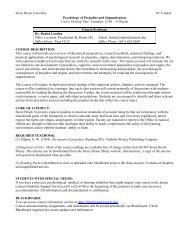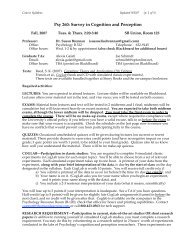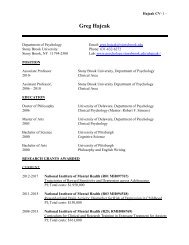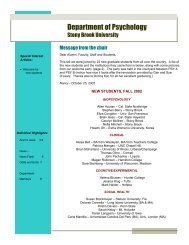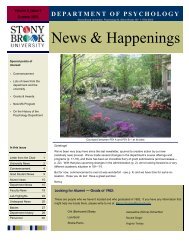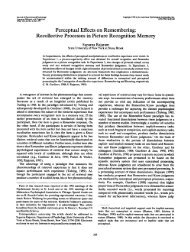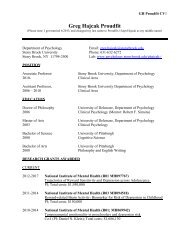Computer-Mediated Communication: A Cognitive Science Approach
Computer-Mediated Communication: A Cognitive Science Approach
Computer-Mediated Communication: A Cognitive Science Approach
You also want an ePaper? Increase the reach of your titles
YUMPU automatically turns print PDFs into web optimized ePapers that Google loves.
Article Number: LALI: 00861<br />
2 <strong>Computer</strong>-<strong>Mediated</strong> <strong>Communication</strong>: A <strong>Cognitive</strong> <strong>Science</strong> <strong>Approach</strong><br />
AU:2<br />
p0030<br />
p0035<br />
p0040<br />
facial expressions and gestures are lost when an interlocutor<br />
can’t be seen; and conversational turns grow<br />
longer with voice mail or e-mail messages than with<br />
media that support more fine-grained interaction,<br />
such as electronic chat or telephone conversations.<br />
Yet perhaps surprisingly, people are able to communicate<br />
quite clearly and easily over a wide variety<br />
of media, including those with relatively low bandwidth<br />
(e.g., text-based media); in fact, cognitive tasks<br />
tend to be accomplished just as well over lower-bandwidth<br />
media as face-to-face (for a comprehensive<br />
review, see Whittaker, 2002). Despite the common<br />
expectation that the more similar a medium is to<br />
face-to-face communication, the better communication<br />
should be, study after study has failed to confirm<br />
this ‘bandwidth hypothesis’ (Brennan, 1990, 1994;<br />
Brennan and Lockridge, 2004; Karsenty, 1999;<br />
Ohaeri, 1998; Whittaker, 2002). Clearly, more bandwidth<br />
is not necessarily better. In fact, mediated communication<br />
sometimes offers tangible advantages<br />
over face-to-face conversation, especially when it is<br />
of value to be able to edit utterances, review them, or<br />
save them as a paper trail; when it is useful to broadcast<br />
them to many addressees at once; or when interlocutors’<br />
schedules prevent them from attending to a<br />
message at the same time.<br />
Some studies have documented media-based differences<br />
in efficiency among task-oriented conversations<br />
(higher efficiency is when the same task is<br />
accomplished just as well in less time or with fewer<br />
words). In comparisons of different configurations<br />
of speech, handwriting, teletyping, and video, Chapanis<br />
and colleagues found early on that remote<br />
communication is much less efficient without speech;<br />
the only way to substantially improve a medium’s<br />
efficiency is to add a voice channel (Chapanis<br />
et al., 1972; Chapanis et al., 1977; Ochsman and<br />
Chapanis, 1974). The ability to coordinate using<br />
speech typically makes a task more efficient by a<br />
factor of two or more.<br />
Yet adding a video channel to a medium that already<br />
includes speech may do nothing to improve<br />
either performance or efficiency (Chapanis et al.,<br />
1972; Chapanis et al., 1977; Ochsman and Chapanis,<br />
1974; Whittaker, 2002; Williams, 1977). Of course,<br />
this depends on what visual information is transmitted:<br />
For cognitive or physical tasks where the focus is<br />
on the task activity, there are few if any benefits to<br />
seeing a partner’s face (Fish et al., 1993; Gaver et al.,<br />
1993; Whittaker, 1995, 2002), despite repeated<br />
attempts by telephone companies and teleconferencing<br />
researchers to supply disembodied talking heads<br />
along with people’s voices. (Seeing the face of a<br />
remote interlocutor can, however, have effects<br />
upon interpersonal social judgments, affiliation, or<br />
adversarial situations involving negotiation; see<br />
Whittaker, 2002 for a review). Visual information<br />
other than faces, such as views of the objects or task<br />
under discussion, can be very useful in task-directed<br />
communication (Anderson et al., 2000; Brennan and<br />
Lockridge, 2004; Clark and Krych, 2004; Kraut et al.,<br />
2002; Whittaker, 1995, 2002). The impact of a particular<br />
kind of visual information can be explained by<br />
the role it plays in grounding.<br />
Consider the task of giving someone driving directions.<br />
This is easiest when both partners can see and<br />
point at the same map. In one study of remote communication<br />
(Brennan, 1990, 2004), two partners had<br />
the same map displayed on their screens and could<br />
speak freely to one another. One, the director, knew<br />
the target location, and directed the other, a matcher,<br />
to move his car icon to the target. Half the time the<br />
director could see on her map where the matcher’s car<br />
was, and half the time she could not (the situation<br />
was asymmetrical; the matcher saw his own car icon<br />
in both conditions). When directors had visual evidence<br />
about matchers’ understanding, matchers quite<br />
literally came to use icon motion to replace their turns<br />
in the conversation. And directors could quickly tell<br />
when matchers understood where the target location<br />
was, so directors took responsibility for deciding<br />
when it was time to move on to the next trial. In trials<br />
without such evidence, directors waited for matchers<br />
to tell them when they understood well enough to<br />
move on. Trials with visual evidence also took less<br />
than half as long as those without, because pairs<br />
could ground in parallel; that is, while the director<br />
presented a description, the partner conducted the<br />
acceptance phase simultaneously by silently moving<br />
his icon (see Figure 1). Without visual evidence (see<br />
Figure 2), he had to give verbal evidence, speaking<br />
after the director’s description, which made the granularity<br />
of interaction much larger.<br />
Grounding in <strong>Mediated</strong> <strong>Communication</strong><br />
FIRST PROOF<br />
In mediated communication, interlocutors typically<br />
inhabit different times and/or different places, so<br />
some aspects of coordination can be more difficult<br />
than in face-to-face conversation, particularly if people<br />
are limited to a medium that does not facilitate<br />
grounding or if techniques for grounding within the<br />
medium are unknown. Table 1, adapted from Clark<br />
and Brennan (1991), compares key affordances of<br />
face-to-face conversation with those of four other<br />
communication media.<br />
Grounding in communication can be decomposed<br />
into various sub-tasks bearing distinct costs (Clark<br />
and Brennan, 1991; Brennan, 1998), with the idea<br />
that people must adapt techniques for grounding to<br />
p0045<br />
s0010<br />
p0050<br />
p0055



